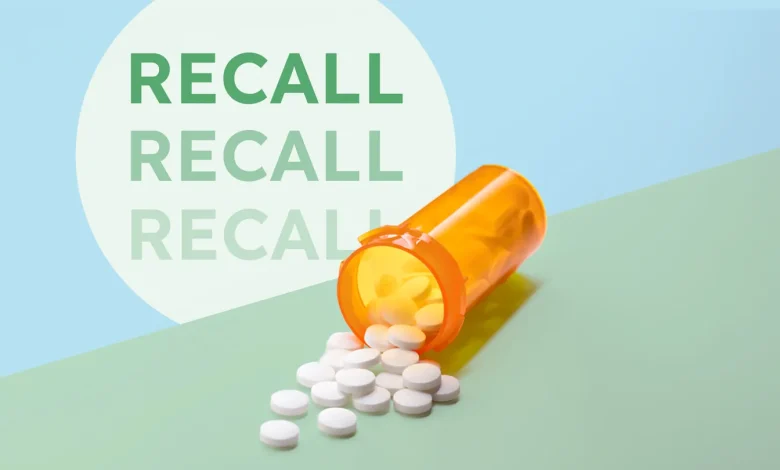FDA Recalls Blood Pressure Medications: Cancer-Causing Chemical Found — Are You at Risk?

A new nationwide recall has thrust another class of blood pressure pills into the headlines. In October 2025 the U.S. Food and Drug Administration (FDA) classified a voluntary recall of more than 580,000 bottles of prazosin hydrochloride — a commonly prescribed blood-pressure medicine — after laboratory testing detected a nitrosamine impurity called “N-nitroso Prazosin impurity C” at levels above the agency’s acceptable limit. The recall was initiated by Teva Pharmaceuticals and later classified by the FDA as a Class II recall, meaning the product “may cause temporary or medically reversible adverse health consequences” but serious outcomes are considered unlikely.
What nitrosamines are, why regulators worry about them, who is likely to be affected, what the actual cancer risk really is, and—most importantly—what you should do if you (or someone you care for) take one of the impacted medicines.
What was recalled and why?
The recall involved multiple bottle sizes (100–1,000 capsules) and strengths (1 mg, 2 mg, 5 mg) of prazosin hydrochloride distributed by Teva. FDA testing identified levels of an N-nitroso impurity (a nitrosamine) in some lots that exceeded the safety threshold defined by the agency’s Carcinogenic Potency Categorization Approach (CPCA). Because nitrosamines are classified as probable or possible human carcinogens, the presence of these impurities triggers regulatory action and product recalls.
Nitrosamines are not new to drug safety news: in past years the FDA and other agencies have found nitrosamine contaminants in certain angiotensin receptor blockers (ARBs) such as valsartan, losartan and irbesartan, as well as in other medicines. Those events led to large recalls beginning in 2018 and additional regulatory scrutiny of manufacturing processes. The prazosin recall follows that same pattern: the impurity is not the drug itself but an unwanted chemical byproduct that can form during synthesis or storage.
What are nitrosamines and why do regulators care?
Nitrosamines are a class of chemical compounds; several nitrosamines (such as NDMA and NDEA) have been classified by health agencies as probable human carcinogens based on animal studies and limited human data. Nitrosamines can show up as trace contaminants in pharmaceuticals because of certain reaction conditions or raw material impurities during drug manufacturing — or in rare cases because of problems in storage or packaging that encourage their formation. The FDA uses conservative modeling (CPCA) to estimate lifetime cancer risk from low-level nitrosamine exposure and sets limits intended to protect public health.
Important point: the drug molecule (prazosin) is not itself a carcinogen in these findings; the concern is the contaminant. That distinction matters clinically — physicians and regulators weigh the known blood-pressure benefits of a medication against the theoretical long-term risk from a contaminant.
Who is most likely to be affected?
The recall specifically lists impacted lot numbers and expiration dates; affected bottles were distributed nationwide. Patients who filled prescriptions for Teva’s prazosin hydrochloride with matching lot and expiration information should assume their bottles may be part of the recall until a pharmacist or prescriber confirms otherwise. Because prazosin is prescribed both for hypertension and off-label for PTSD-related nightmares, the affected population includes patients taking it for either purpose.
That said, not everyone taking blood-pressure drugs is affected — this recall is limited to specific prazosin lots distributed by a single manufacturer. Other antihypertensive medicines or prazosin from different manufacturers or lots may not be implicated. Always check lot numbers before making changes.
How big is the cancer risk?
This is the question everyone wants answered: “If I took a recalled bottle, am I going to get cancer?” Short answer: very unlikely for most patients, but the agencies treat even very small potential risks seriously.
Regulatory context:
- The FDA’s CPCA approach estimates theoretical lifetime cancer risk from low-level exposures to nitrosamines and sets limits intended to keep that lifetime risk extremely low. A product that exceeds the CPCA limit fails to meet the agency’s standard for acceptable risk, which triggers recall actions even when the absolute risk is small. What science shows:
- Large population-level studies of earlier nitrosamine-tainted ARB recalls suggested small or very modest increases in certain cancer types in some analyses, but the absolute increase in risk for an individual who briefly used a contaminated lot is typically tiny. For example, some epidemiologic analyses of past NDMA exposure through contaminated valsartan showed slight associations with certain cancers, but results vary and the estimated excess cancer incidence was small compared to other common risks (smoking, obesity, etc.). Researchers continue to study long-term outcomes.
Put another way: regulators recall a drug when contamination exceeds conservative safety limits — that does not mean every exposed patient will get cancer. The FDA’s action is preventive: stop further exposure and give patients and prescribers the information they need to make safe choices.
Immediate steps if you have the medicine
- Don’t panic. Serious adverse effects from this recall are considered unlikely, and no illnesses have been definitively linked to these lots so far.
- Check the label and lot number. Compare the lot and expiration date on your bottle with the recall list posted by the FDA or your pharmacy. If you don’t want to search yourself, call your pharmacy and ask if your prescription is included.
- Do not stop taking blood-pressure medication without medical advice. Abruptly stopping antihypertensive therapy can be dangerous. If your bottle is on the recall list, contact your prescriber or pharmacist to arrange an immediate, safe alternative.
- Return or dispose as instructed. Many pharmacies will accept recalled medications; the FDA and your pharmacy can advise on proper disposal. If your pharmacy asks you to bring the bottle in for exchange or disposal, follow their instructions.
- Ask your prescriber about alternatives. There are numerous effective blood-pressure drugs across several classes (ACE inhibitors, ARBs, calcium-channel blockers, thiazide diuretics, alpha blockers like prazosin, etc.). Your clinician can select an appropriate substitute based on your overall health, other medications, and indications (e.g., PTSD vs hypertension).
If you have questions or need to confirm a recall, the FDA typically posts enforcement reports and recall notices online and maintains a hotline (1-888-INFO-FDA) for consumers.
Should you be screened differently because of exposure?
There is no established guideline that a single short-term exposure to nitrosamine-contaminated medicine requires immediate cancer screening beyond routine care. Decisions about additional surveillance should be personalized: if you have prolonged exposure to a recalled product or other cancer risk factors (significant smoking history, family history, prior radiation, etc.), discuss this with your provider. Public health authorities generally recommend replacing the contaminated medicine to stop further exposure and monitoring patients according to standard preventive care, not immediate special screening.
How did this keep happening? A quick manufacturing primer
Drug manufacturing is complex. Small changes in reagents, solvents, catalysts, or purification steps — or contamination in raw materials — can create unwanted byproducts. Nitrosamines can form under certain chemical conditions; sometimes they’re introduced through contaminated raw materials or form during storage. Regulatory agencies and industry have increased testing and tightened guidance since the first ARB recalls in 2018, but new impurity types or lapses still occur. The FDA inspects facilities, issues guidance on controlling nitrosamines, and categorizes recalls based on risk.
What regulators and manufacturers are doing
After the 2018–2021 wave of nitrosamine findings, regulators globally required additional testing and risk-mitigation in manufacture. In the current prazosin case, the recall was voluntary (initiated by the manufacturer), and the FDA classified it as Class II after reviewing the data — a move that balances transparency with an assessment that immediate, life-threatening risk is unlikely. The manufacturer and distributors typically notify pharmacies and provide lists of affected lots; regulators continue to monitor for adverse events and may require corrective manufacturing steps.
Practical advice for patients & clinicians
For patients:
- Keep taking your medication until you’ve confirmed whether your lot is affected — then follow your clinician’s plan for switching safely. Abrupt medication changes can raise blood pressure and risk.
- Keep a medication list and a current pharmacy contact; those details make it quicker for the pharmacist to check lots.
- If your prescriber switches your drug, make sure you understand new dosing, possible side effects, and monitoring needs.
For clinicians:
- Review the FDA enforcement report and recall lot list for your patients’ prescriptions. Contact patients taking affected lots proactively.
- When switching therapy, consider the patient’s entire cardiovascular and comorbidity profile (e.g., heart failure, diabetes, pregnancy potential, PTSD symptoms if prazosin is treating nightmares).
- Report any adverse events possibly linked to the recalled product to the FDA’s MedWatch system.
Putting the risk into perspective
It’s reasonable to be concerned when “cancer” and “medicine” are mentioned together. But keep perspective: regulatory safety limits are intentionally conservative. For most patients, a short-term exposure to a recalled lot translates into a very small increase in theoretical lifetime cancer risk — not a near-certain outcome. The recall is about preventing unnecessary exposure going forward and ensuring manufacturing quality. If you’re worried, have a frank conversation with your healthcare provider; they can interpret the risk for your personal health context and help you switch medications safely.
The broader lesson: stronger oversight and transparency matter
Recurring nitrosamine recalls over recent years have pushed improvements: tighter regulatory guidance, enhanced manufacturer testing, and more transparent recall communications. Still, these events remind patients and clinicians that pharmaceutical quality control is an ongoing challenge and that vigilance (by manufacturers, inspectors, pharmacists, prescribers, and patients) is essential. Regulators are increasingly using robust testing methods and risk-based modeling to minimize future events, but occasional problems may continue to appear until root causes are eliminated across supply chains.
Quick checklist — what to do right now
- Check your medicine label: strength, bottle size, lot number, expiration date. Compare to the FDA recall list or call your pharmacy.
- If your bottle is on the recall list, don’t stop taking it without medical advice — contact your prescriber immediately to arrange a safe replacement.
- Report concerns or adverse effects to your pharmacy and the FDA (MedWatch) if you believe you’ve experienced harm.
- Keep routine preventive care; discuss any long-term cancer screening questions with your clinician based on your personal risks.
Final words
FDA recalls like this can be alarming — and they should be taken seriously. But they are also evidence that the safety system is working: impurities were detected, manufacturers issued recalls, and regulators classified and communicated the risk. For most patients, the short-term health risk from this particular recall is low; the immediate priority is stopping further exposure and safely transitioning to an unaffected medicine if needed. If you have a recalled bottle, contact your pharmacy or prescriber today — but don’t stop your medication without medical guidance.




